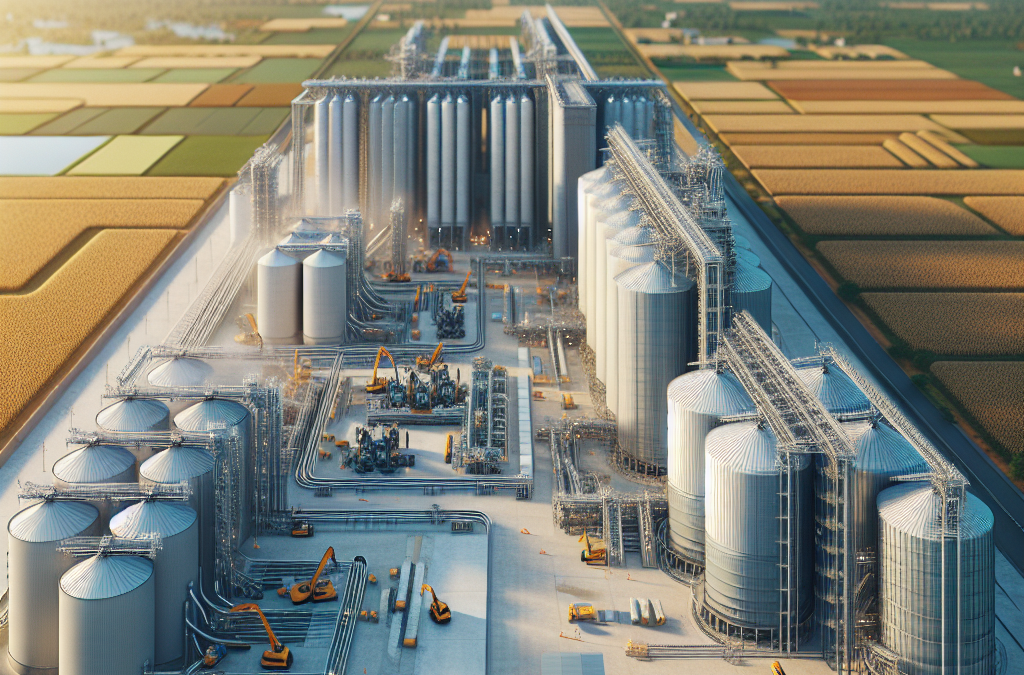Smart Technology Integration
Embracing IoT for Efficiency
One of the coolest trends I’ve seen in grain storage is the rise of smart technology, particularly the Internet of Things (IoT). Imagine being able to monitor your grain storage conditions from anywhere! This tech allows farmers and storage facility managers to keep an eye on humidity, temperature, and even pest infestations in real-time. It’s a total game-changer.
Picture checking your smartphone while you sip your morning coffee, seeing the optimal conditions maintained in your silo across town. With smart sensors feeding data directly to your devices, you can make decisions on the fly, whether it’s adjusting ventilation or adding drying agents. Trust me, it makes the whole process so much easier and less stressful.
Moreover, using IoT technology can also lead to big cost savings in the long run. By being proactive with data, you can prevent spoilage and reduce waste. This not just benefits your bottom line; it’s also a win for sustainability—a trend that’s here to stay.
Automation in Grain Handling
When I think about how far grain storage has come, automation really stands out. Automated systems for grain handling can increase efficiency like you wouldn’t believe. From automated temperature controls to robotic hands that manage the loading and unloading of grain, the possibilities are pretty impressive.
It’s like having an extra set of hands that never get tired. These systems allow for smooth operations, reducing the risks of human error at the same time. And let’s be honest: who really wants to be lugging around heavy sacks of grain during harvest season? With robotics, it’s all about easing the physical toll on workers.
Plus, automation can help maintain a consistent workflow. Imagine machines reliably performing their tasks without needing to break for lunch or ask for overtime. This not only boosts productivity but also ensures that grain is stored and processed correctly.
Use of Drones for Monitoring
Let’s not forget about drones. Yes, you read that right! Drones are transforming the way we monitor grain storage and outdoor farming. Imagine flying a drone over your fields, taking high-resolution images to assess the condition of your crops and storage facilities.
Using drones allows farmers to gather information quickly that would take a lot more time on foot. They can identify potential issues like pest problems or water shortage from above, allowing for faster reactions and less waste. It’s a nifty way to keep your operations running smoothly without breaking a sweat.
The aerial insights that drones deliver can also help in post-harvest assessments, ensuring that your grain is ready for storage without hidden surprises. Ask any farmer, and they’ll confirm that timely knowledge can make all the difference.
Innovative Storage Solutions
Modular Storage Systems
One of the innovations that I feel passionate about is modular storage systems. These systems not only allow for flexibility in terms of space but also can be adjusted according to the specific needs of each operation. Whether you’re storing pulses, spices, or grains, modular designs offer a custom fit.
They make expanding your storage capabilities easier than ever. If you need to scale up during harvest, or down when capacity isn’t needed, you can configure these systems to meet your exact demands. I’ve seen operations boost their efficiency significantly thanks to this adaptability.
On top of that, modular systems can often be designed to optimize airflow and temperature control, which are critical for maintaining grain quality. It’s an investment worth considering if you’re serious about storage solutions.
Advanced Grain Bins
Let’s chat about advanced grain bins for a moment. New materials and technologies are making these bins not only stronger but also more efficient. For instance, some bins are now equipped with built-in aeration systems that help control the temperature and moisture levels inside. This is super important in preventing spoilage and maintaining quality.
What’s truly exciting is that today’s bins often come with features that allow for better pest control as well. Advances like sealed systems can significantly deter grain-eating pests, which saves headaches down the line. Who doesn’t want that?
Moreover, the ability to track grain conditions from within the bins using wireless sensors is a massive leap forward. With the data at your fingertips, you can take timely actions to avoid losses, which ultimately protects your investment.
Eco-friendly Storage Options
With today being all about sustainability, it’s stunning how eco-friendly storage options are becoming prominent. I’ve personally seen more and more operations switch to biodegradable materials for packaging and storing grain. It just goes to show that we’re beginning to care not just about profits, but about the planet too.
Moreover, solar-powered storage solutions are also emerging. By utilizing renewable energy, these options lower operational costs over time while reducing reliance on fossil fuels. To me, that’s a win-win: helping the environment and saving some cash!
Switching to eco-friendly options isn’t just a trend; it’s a necessity in today’s world. Not to mention, adopting green practices can enhance a brand’s reputation, opening doors to new customers who prioritize sustainability in their purchasing decisions.
Improved Quality Control Methods
Innovative Testing Techniques
Quality control is a biggie when it comes to grain storage, and the techniques have really evolved. New, innovative testing methods allow for quicker assessments of grain quality. Tools like in-field testing kits and digital analysis platforms can drastically cut down the time it takes to determine whether your grain is in prime condition.
These technologies allow farmers to quickly diagnose problems before they escalate into serious issues. Think of it as having a personal trainer for your grain; keeping it in check and giving it the support it needs.
By implementing these faster testing techniques, we can make informed decisions on how to manage our grain, ensuring that only the best quality reaches consumers. It’s not just about harvest; it’s about maintaining standards throughout the storage process.
Get Whole Wheat Flour, Grains and Milling Supplies – CLICK HERE
Regular Monitoring and Maintenance
You know what they say: an ounce of prevention is worth a pound of cure. Regular monitoring and maintenance are essential in ensuring that grain is stored correctly. I always stress the importance of checks—regularly inspecting silos, bins, and storage systems to catch any potential issues early on.
This proactive approach can save time and money. Delaying repairs can lead to bigger problems, whether it’s equipment failure or grain spoilage. I’ve learned the hard way that staying ahead of these issues is crucial!
Also, ensuring that all equipment is well-maintained can lead to increased efficiency. Who likes dealing with malfunctioning gear when time is of the essence? Keeping everything in top shape can boost your output and alleviate stress during busy seasons.
Data Analytics for Grain Quality
Using data analytics is like having a crystal ball for predicting grain quality over time. By leveraging software that analyzes grain data, farmers can forecast trends and make data-driven decisions to enhance quality control. Honestly, it makes such a difference when you can back your decisions with solid data.
Employing analytics tools can help understand how various factors influence grain quality, like storage time, temperature fluctuations, and even humidity levels. This insight can guide tweaking storage strategies to ensure optimal preservation.
In the end, this data-driven mindset not only helps to improve quality but can also lead to higher market prices. When consumers know they’re getting quality, they’re more willing to pay for it. It really shows that investing in technology is an investment in the future.
Adoption of Sustainability Practices
Responsibility in Sourcing Materials
When it comes to sustainability, I’m all about responsible sourcing. Whether it’s the materials used for storage bins or packing materials, choosing sustainably sourced products can have a significant impact. Not only does this lower your carbon footprint, but it also pushes the entire industry towards greener practices.
Over the years, I’ve learned that being mindful of sourcing doesn’t just benefit the environment; it can also enhance brand image. Consumers appreciate when companies are upfront about their sustainable efforts, often leading to increased loyalty and trust.
It’s essential that every business understands its supply chain’s impact and makes efforts to choose responsible sources. It’s a positive step for our industry, ensuring that we positively influence both our livelihoods and the planet.
Minimizing Waste in Operations
Waste can be a major concern in grain storage, but I’m thrilled to see so many efforts towards minimizing it. By implementing smarter processes and technologies, operations can drastically cut down on the waste created during storage and transport.
One method is repurposing byproducts. Everything from grain dust to leftover packaging can be recycled or transformed into biofuel. This proactive recycling not only reduces waste but also opens new revenue streams.
When waste becomes resourceful, you’re creating a win-win situation for both sustainability and profitability. I’ve seen businesses flourish after embracing these alternative waste management strategies.
Community Engagement in Sustainable Practices
Community plays a huge role in sustainability, and I can’t stress enough the importance of engaging local groups. Promoting sustainability practices within the community can create a ripple effect, encouraging others to adopt similar practices.
Local partnerships also enhance efforts as they increase awareness of sustainable agriculture and grain storage. Farmer education and community-centric initiatives promote the sharing of resources, knowledge, and best practices.
When sustainability is seen as a cooperative effort within the community, it creates a sense of collective responsibility that can motivate change. The more we share, the stronger we become, and the better we can care for our planet.
FAQs
What types of technology are becoming popular in grain storage?
Smart technology, including IoT devices, automation, and drones, are leading the charge in modern grain storage solutions. These technologies help streamline operations, monitor conditions, and improve efficiency.
How can farmers benefit from sustainable grain storage practices?
By adopting sustainable practices, farmers can lower their environmental impact, improve their efficiency, and potentially enhance their brand image, attracting more consumers who value sustainability.
What role does data play in grain quality control?
Data analytics provide insights that help predict and maintain grain quality over time. They allow farmers to make informed decisions and optimize their storage conditions for the best quality product.
Are there benefits to modular storage systems?
Yes! Modular storage systems offer flexibility and adaptability, allowing operations to scale according to need while optimizing airflow and moisture control, which are critical for maintaining quality.
What is the impact of automation in grain handling?
Automation reduces human error, increases efficiency, and can ease the physical demands on workers. It enables smoother operations and helps ensure that grain is stored and managed correctly.
Get Whole Wheat Flour, Grains and Milling Supplies – CLICK HERE
Related Content
Auto Amazon Links: No products found.





